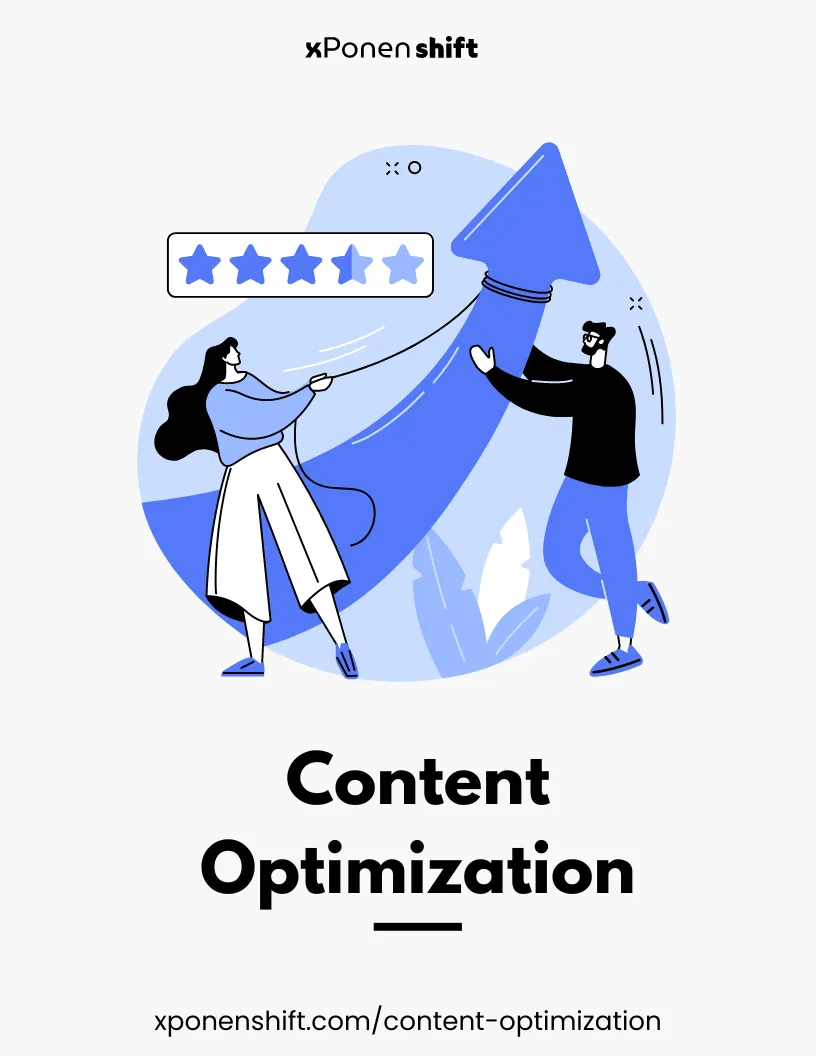- admin
- On-Page SEO
- 0 Comments
- 127 Views
Optimizing content quality for both human readers and search engines is like baking a cake that everyone loves—it needs the right balance of ingredients.
In content creation, these ingredients are informative and engaging writing for the readers, and strategically placed keywords and structure for the search engines.
The ultimate goal is to provide valuable information that satisfies the reader’s query while also adhering to SEO practices that boost search engine rankings.
To achieve this, you’ll start by understanding your audience’s needs, then incorporate relevant keywords naturally, structure your content with clear headings, and ensure it is engaging and easy to read.
These steps help make sure your content appeals to both humans and the algorithms that determine search engine rankings.
Creating articles that are equally engaging for humans and effective for search engine robots involves a mix of art and science. Here’s how to make it work:
1. Readability for Humans
When discussing “Readability for Humans,” we’re focusing on how easily a person can understand and enjoy the content.
This involves clear language, logical flow, and a friendly tone. In the context of residential property or real estate, ensuring your content is readable is crucial for engaging potential homebuyers or investors who may not be familiar with real estate jargon.
Key Aspects of Readability:
- Simple Language: Use straightforward and clear language to explain concepts. Avoid industry jargon unless it is commonly understood or you provide a definition. For example, instead of using “amortization,” you could simplify it with “the process of paying off your home loan over time.”
- Logical Flow: Organize information in a logical sequence that builds understanding. Start with general information about the property market and narrow down to specific aspects like types of homes, financing options, or tips for first-time buyers.
- Friendly Tone: Maintain a conversational and inviting tone. This helps in making the reader feel more at ease, as if they are receiving advice from a friend. For instance, when explaining property investment, you might say, “Think of buying your first home as starting a new adventure, where you get to put your personal touch on every corner.”
Example of Readable Content Using the Keyword ‘Residential Property‘:
Title: Easy Guide to Buying Your First Home
Opening paragraph:
“Are you thinking about buying your first home but not sure where to start? Don’t worry, you’re not alone. Purchasing a residential property is a big step, and we’re here to help make it as easy as possible for you. This guide will walk you through every step of buying your home, with straightforward advice that’s easy to follow.”
Main body:
“Understanding the Basics of Residential Property – A residential property is simply any property used for living, not for commercial purposes. These can range from apartments and condos to single-family homes and townhouses. Let’s break down what these terms mean so you can decide what’s best for your needs:
- Apartment: A small, manageable space perfect for individuals or small families. It’s often part of a larger building with several units.
- Condo: Similar to an apartment, but you own it. It’s ideal if you want a place of your own without the hassle of managing a yard.
- Single-family Home: A standalone house offering privacy and space, great for growing families or if you just need more room.
- Townhouse: A middle ground between a condo and a single-family home, offering more space than a condo without the maintenance of a large yard.
Financing Your Home: Buying a home usually involves getting a mortgage—a long-term loan given by banks to help cover the cost of the property…”
This example shows how to present real estate concepts in a friendly and understandable manner, which is crucial for readability. By breaking down terms, providing clear definitions, and using a warm tone, the content becomes accessible and engaging for readers who might be new to the real estate market.
2. Engaging Content
Creating engaging content is about capturing and maintaining the reader’s interest. It involves using elements that resonate with the audience, such as relevant stories, practical advice, visuals, and interactive elements.
For the real estate industry, engaging content not only informs potential buyers or sellers but also encourages them to take action, such as contacting a realtor or visiting a property.
Key Aspects of Engaging Content:
- Relevance: Tailor the content to meet the needs and interests of your target audience. For residential property topics, this could mean focusing on advice for first-time homebuyers, investment tips for seasoned buyers, or design ideas for new homeowners.
- Use of Stories and Examples: Incorporate real-life stories or hypothetical scenarios that the reader can relate to. This could include success stories of individuals who navigated the complex process of buying their first home, or a walkthrough of a day in the life of a property investor.
- Visuals and Media: Add photos, videos, and infographics to break up text and add a visual element to your content. For example, before-and-after images of a renovated home or video tours of residential properties can greatly enhance engagement.
- Interactive Elements: Include tools like mortgage calculators, interactive maps, or quizzes that personalize the experience. For instance, an interactive map showing available properties in different neighborhoods can help buyers pinpoint locations they are interested in.
Example of Engaging Content Using the Keyword ‘Residential Property’:
Title: Discover Your Dream Home: A Visual Journey Through Today’s Top Residential Properties
Opening paragraph:
“Imagine opening the door to your dream home. What do you see? Whether it’s a cozy cottage with a white picket fence or a sleek modern condo in the heart of the city, finding the right residential property can be a thrilling adventure. Join us on a visual journey through some of today’s most sought-after homes and find inspiration for your own.”
Main body:
“Explore a Variety of Home Styles: From charming Victorians to ultra-modern lofts, every potential homeowner has a unique taste. Here’s a closer look at what makes each style special:
- Victorian Homes: Known for their intricate woodwork and romantic charm. Picture yourself enjoying a quiet evening on a classic wrap-around porch.
- Modern Lofts: With open floor plans and industrial elements, lofts offer a dynamic living space in urban centers. Imagine living steps away from your favorite coffee shop and cultural hotspots.
Visual Guide to Choosing the Right Neighborhood: Not sure where to start your home search? Check out our interactive map of popular neighborhoods, complete with photos and key statistics. Click on each area to see available properties and learn about local amenities, schools, and more.
Real-Life Success Stories: Read about how the Thompson family found their perfect starter home in a competitive market, and how they turned a challenging house-hunting experience into a triumph with the right resources and advice.
Engagement through relatable content, interactive tools, and compelling visuals makes the process of learning about residential properties both informative and enjoyable. This approach not only keeps readers coming back but also encourages them to engage more deeply by exploring additional resources or contacting a real estate expert.
3. Proper Structure
Proper structure in content creation involves organizing information in a way that guides the reader logically from introduction to conclusion.
This structuring not only improves readability but also enhances the effectiveness of SEO by making it easier for search engines to crawl and index key points.
In the context of residential property content, a well-structured article can help potential buyers or sellers quickly find the information they need, enhancing user experience and engagement.
Key Aspects of Proper Structure:
- Clear Hierarchy: Use headings and subheadings to create a hierarchy that outlines the content. This helps both readers and search engines understand the main and sub-topics covered. For instance, using H1 for your main title, H2 for major sections, and H3 for subsections within those.
- Logical Flow: Arrange content so that each section naturally leads to the next. Start with a broad introduction to the topic, then narrow down to specific details, and finally, conclude with a summary or call to action. This could be starting with an overview of the real estate market, followed by detailed advice on home buying, and ending with tips for securing financing.
- Accessibility: Make sure the content is accessible by using bullet points for lists, short paragraphs to break up text, and including internal links to other relevant articles or sections within the content. This aids in navigation and makes the content more digestible.
Example of Proper Structure Using the Keyword ‘Residential Property’:
Title: Your Ultimate Guide to Buying a Residential Property
Introduction:
“Looking to buy a residential property but don’t know where to start? This guide provides a comprehensive overview of the process, from choosing the right type of home to securing financing.”
Main Body:
H2: Types of Residential Properties
- H3: Single-Family Homes
- Description and benefits
- Example properties
- H3: Condominiums
- Description and benefits
- Example properties
- H3: Townhouses
- Description and benefits
- Example properties
H2: Steps in the Home Buying Process
- H3: Understanding Your Budget
- How to calculate your budget
- Tips on saving for a down payment
- H3: Choosing the Right Location
- Factors to consider
- Comparison of popular residential areas
H2: Securing Financing
- H3: Types of Mortgages
- Fixed-rate vs. variable-rate mortgages
- How to choose the right one for you
- H3: Getting Pre-Approved
- Importance of pre-approval
- Steps to getting pre-approved by lenders
Conclusion:
“Buying a residential property is a significant milestone. By understanding the types of homes available, the buying process, and financing options, you’re better equipped to make an informed decision. Remember, this journey is a major financial commitment and choosing the right home involves careful consideration and planning.”
This structured approach not only makes the content easier to navigate but also helps ensure that readers can follow the information logically, enhancing understanding and retention.
Such organization also boosts SEO performance by emphasizing key topics through headings and ensuring a comprehensive coverage of the subject.
4. Keyword Optimization
Keyword optimization is the strategic use of relevant words and phrases within your content to ensure it is discoverable by search engines and matches the search queries of your audience.
In the realm of residential property, effective keyword optimization helps potential buyers, sellers, or investors find your content when they search for information related to buying, selling, or investing in homes.
The process involves more than just sprinkling terms throughout your text; it requires thoughtful placement and consideration of how these keywords align with user intent and content relevancy.
To carry out correct keyword optimization, here are the steps you can take:
- Keyword Research: Begin with comprehensive keyword research to identify terms that your target audience uses when searching for residential properties. Tools like Google Keyword Planner or SEMrush can help you find both broad and long-tail keywords that are relevant to your topic. For instance, besides “residential property,” you might find valuable keywords like “affordable homes for sale” or “best cities for real estate investment.”
- Strategic Placement: Once you have your keywords, place them strategically within your content. Key positions include the title, headers, the first paragraph, and the conclusion. Also, incorporate them into the meta descriptions and ALT tags of images. Ensure that their placement feels natural and enhances readability rather than disrupting it.
- Balancing Keyword Density: The frequency of your keywords is also crucial. Too many can lead to keyword stuffing, which negatively impacts SEO and reader experience. A good rule of thumb is to maintain a keyword density of about 1-2%, ensuring the text remains natural and engaging.
- Synonyms and Related Terms: Use synonyms and related terms to avoid repetitiveness and to cover more variations of user searches. This approach, known as LSI (Latent Semantic Indexing), helps improve SEO without keyword stuffing. For a keyword like “residential property,” related terms could include “housing,” “real estate,” “homes,” and “properties.”
Example of Keyword Optimization Using the Keyword ‘Residential Property’:
Title: Essential Tips for Finding the Perfect Residential Property
Introduction:
“Are you in the market for a residential property? Whether you’re a first-time buyer or looking to invest in real estate, finding the right home can be daunting. This guide will walk you through essential tips to make your search as smooth as possible.”
Main Body:
H2: Exploring Affordable Residential Properties
- Discuss the importance of setting a budget and how to find properties within it.
- Mention “affordable homes for sale” and “cost-effective real estate options.”
H2: Best Cities to Buy Residential Real Estate
- Analyze top cities known for their real estate market, using terms like “top real estate markets” and “best cities for property investment.”
H2: How to Evaluate a Residential Property
- Offer advice on what to look for in a home, including “property assessments” and “real estate evaluations.”
Conclusion:
“Securing the right residential property is about thorough research and understanding the market. Use these tips to navigate the complexities of real estate and make informed decisions. Remember, the perfect home awaits those who are prepared.”
By integrating keywords thoughtfully and organically throughout your content, you enhance its visibility and relevance in search engine results, making it more likely that your target audience will find and engage with your articles.
5. Meta Descriptions and Title Tags
Meta descriptions and title tags are crucial HTML elements that can significantly influence both click-through rates from search engine results pages (SERPs) and the overall SEO effectiveness of your content.
For content related to residential property, well-crafted meta descriptions and title tags ensure that your articles stand out to potential home buyers, sellers, or real estate investors when they search online.
What you should pay attention to when optimizing Meta Descriptions and Title Tags is:
Purpose and Importance:
- Title Tags: These appear as the clickable headline for a given result in the SERPs and are essential for SEO, usability, and social sharing. The title tag should be concise, clear, and include your main keyword.
- Meta Descriptions: These provide a brief and compelling summary of the page content in the SERPs. While they don’t directly influence search rankings, a well-written meta description can improve the likelihood of someone clicking on your content.
Best Practices:
- Length: Keep title tags under 60 characters to ensure they display fully in the SERPs. Meta descriptions should be about 150-160 characters to avoid being cut off.
- Keyword Placement: Include primary keywords near the beginning of both the title tag and meta description to emphasize relevance.
- Call to Action: Use actionable language in the meta description to encourage clicks, such as “Learn more,” “Discover,” or “Find out.”
Relevance and Specificity: Make sure both elements are relevant to the content of the page. They should accurately reflect the page’s content to meet user expectations and reduce bounce rates.
Example of Meta Descriptions and Title Tags Using the Keyword ‘Residential Property’:
- Title Tag: “Buy Your Dream Home: Top Residential Properties for Sale”
- This title is engaging, contains the main keyword “Residential Properties,” and clearly states what the page is about.
- Meta Description: “Explore our curated list of residential properties for sale. Discover affordable homes and luxury estates to find the perfect match for your lifestyle. Start your journey home today!”
- This meta description uses a call to action (“Start your journey home today”), includes relevant keywords (“residential properties for sale,” “affordable homes,” “luxury estates”), and is written to entice the user to click through.
By optimizing your meta descriptions and title tags, you not only enhance your content’s visibility and appeal in search results but also provide a clear, immediate insight into the content’s value, which can significantly influence user engagement and site traffic.
6. Mobile Optimization
Mobile optimization is the process of adjusting your website’s content and design to ensure that it provides an effective, engaging, and enjoyable experience on mobile devices.
This is crucial for topics like residential property, as potential buyers often use their smartphones to search for homes, browse listings, and contact agents on the go.
Key Aspects of Mobile Optimization:
- Responsive Design: Ensure your website uses a responsive design, which automatically adjusts the layout, images, and content to fit different screen sizes and orientations. This prevents issues like text that’s too small to read or navigation that’s difficult to use on a mobile device.
- Speed Optimization: Mobile users expect quick loading times. Optimize images, leverage browser caching, and minimize code (CSS, JavaScript) to enhance loading speeds. Google’s PageSpeed Insights can be a valuable tool to check your site’s performance and get specific recommendations.
- User-Friendly Navigation: Simplify navigation to make it easy for users to find information with just a few taps. Use large, easy-to-tap buttons and keep the menu structure simple. Avoid using dropdowns that are difficult to manage on small screens.
- Touchscreen Readiness: Design your site with touchscreen navigation in mind. Ensure that buttons and links are of a suitable size and spaced out to avoid accidental clicks. Interactive elements like sliders or toggles should be easy to use on touch devices.
- Mobile-Friendly Content: Content should be concise and easy to skim, with plenty of headings, short paragraphs, and bullet points. Long blocks of text can be daunting on small screens, so breaking up text helps maintain user engagement.
Example of Mobile Optimization in Use with Residential Property Content:
Imagine a website that features residential property listings. The homepage might display a clean, minimalistic design with a search bar prominently placed at the top.
Below, there could be large, tappable areas featuring the latest properties, special deals, and advice for buyers.
Each listing would include high-quality, fast-loading images of the properties, succinct descriptions, and clear calls to action like “Contact Agent” or “View Details,” each button sized appropriately for tapping.
The property search function would be simplified, allowing users to easily select filters such as location, price range, and property type without cumbersome typing.
On the listing page, important information like key features, price, and agent contact details would be displayed prominently, making it easy for mobile users to grasp the essentials quickly and take action, such as scheduling a viewing or requesting more information.
By focusing on these elements, a real estate website can offer a superior mobile user experience, which is essential in today’s market where more and more users are accessing information on the go.
This approach not only improves user satisfaction but also boosts SEO, as search engines like Google prioritize mobile-optimized sites in their rankings.
7. Internal and External Links
Internal and external linking are key components of an effective SEO strategy and enhance the user experience by providing additional context or resources.
For content related to residential property, these links can guide users to more detailed information, support your claims with credible sources, or keep users engaged with related content on your site.
Key Aspects of Internal and External Links:
Internal Links:
- Purpose: Internal links connect one page of your website to another. This not only helps users navigate your site but also helps search engines discover new pages and understand the structure and hierarchy of your content.
- Best Practices:
- Use descriptive anchor text that indicates the linked page’s content.
- Link to relevant content that enhances the user’s understanding or adds value.
- Maintain a reasonable number of internal links to avoid overwhelming the user and diluting the page’s value.
External Links:
- Purpose: External links point from your website to different domains. These are used to verify facts, provide sources for your data, or direct users to additional resources.
- Best Practices:
- Link to reputable, authoritative websites to boost the credibility of your content.
- Ensure the external links open in a new tab so users can easily return to your original content.
- Regularly check external links to ensure they are not broken and the content they point to is still relevant and appropriate.
Example of Internal and External Linking for Residential Property Content:
Imagine an article titled “5 Key Trends in the Residential Property Market for 2024” on a real estate website.
Internal Links:
- Link from the mention of “recent market fluctuations” to a previous article discussing last year’s market overview.
- From a section discussing “investment opportunities,” link to your page on investment services for real estate.
- Anchor text example: “Learn more about our property investment services here.”
External Links:
- When citing statistics about market growth, link to a recent study or report published by a recognized real estate or economic research institute.
- If you mention a specific real estate law change, link to the government or legal resource where readers can read the official documentation.
- Anchor text example: “Read the full report on 2024 real estate trends at [Institute Name].”
By strategically using internal and external links, you not only enrich your site’s SEO profile but also provide a more engaging, informative, and credible user experience.
These linking practices ensure that your site becomes a valuable resource for anyone interested in residential properties, thereby increasing traffic, user engagement, and ultimately conversions.
By focusing on these detailed aspects, your content becomes more attractive and useful to both your readers and the search engines, increasing the likelihood of higher traffic and engagement.




